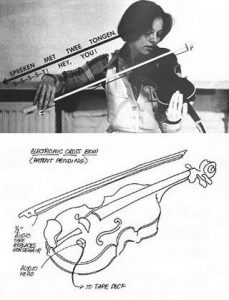I am using one of my late days for this post.
One exciting project that I found was the live visuals performed by Mary Franck which accompanied electronic music performed by an assortment of artists, including Holly Herndon, Mike Gao, Luke Dahl, Colin Sullivan, Jennifer Hsu & Locky. This took place at the Modulations showcase in 2013 (an annual event that is hosted by Stanford’s Center for Computer Research in Music and Acoustics).
The performance involved a large screen which was placed behind the musicians on stage, and displayed on the screen was a progression of colorful, moving, geometric designs and dream-like images. The live visuals were created using a TouchDesigner program that Franck developed, known as Rouge, which is used for video performance and creating realtime 3D compositions.
I think this kind of audiovisual performance is really cool because of the way that it feels liberating – all the artists involved are able to realize spontaneous ideas and bring these dynamic ideas to life. This project is relevant to my final project because it uses both sound and visuals to create a whole experience.
Another project that is inspiring to me is the tape bow violin, invented by Laurie Anderson in 1977, which had a large influence in the processes of integrating music and technology. She replaced the horsehair on the violin bow with magnetic tape, and put a tape head on the bridge of the violin. Using this technology, she was able to create non-traditional sounds using the violin by manipulating the sounds captured with the tape (for example, sound could be played backwards or forwards, and rearrange parts of the sound). I think that this project is relevant to my final project because of the way in which it deals with changing conceptions of the sound that can be produced using a traditional instrument. In my project, I intend to use a visual concept of an instrument that has some traditional characteristics, and pair it with non traditional sounds (produced by the user’s keyboard).

I think both of these artists works are interesting to compare because they come from different eras, but both advance the ways in which technology can be integrated with music.
![[OLD FALL 2018] 15-104 • Introduction to Computing for Creative Practice](wp-content/uploads/2020/08/stop-banner.png)